Trash Bag Sizes: Popular Options & How to Choose
Author: Anne Cowart | Editor: Omar Alonso
Review & Research: Jen Worst & Chris Miller
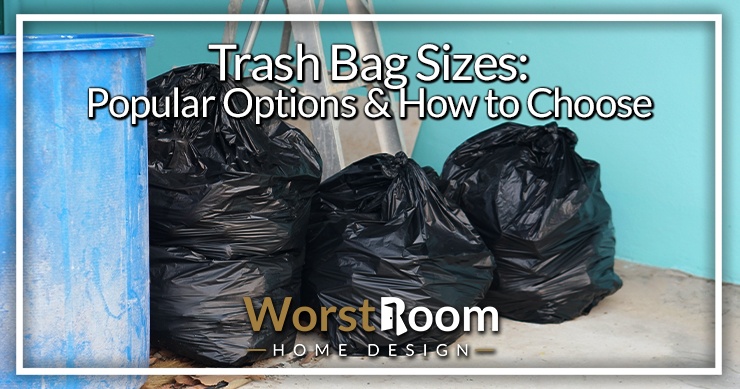
Trash bags are essential to keeping your home or business clean and tidy. Choosing the right trash bag sizes can help make waste management more efficient, reduce the risk of spills and leaks, and prevent the need for multiple trips to empty the trash.
Nowadays, there are a wide variety of trash bags available in different sizes. The size you need depends on the amount of trash you want to dispose of. Designers create some bags specifically for types of waste like yard or kitchen waste, while others create bags based on capacity.
Trash bags come in many shapes and sizes, each suited for a particular purpose. The most common design is the rectangular trash bag, used at home and in commercial settings. Other popular designs include the flat-bottomed bag, commonly used in industrial environments, and the gusseted bag, widely used with trash and recycling bins.
When choosing a trash bag, it's essential to know the shape and size of your waste container. The bag should be larger than the gallon capacity and match the width of the bin. To determine the right size, measure the width of your trash bin and look for a bag that is equal to or larger than that size.
For instance, a 24 gallon bin with a width of 40 inches would require a 40 to 45 gallon bag. If you're having trouble selecting the appropriate trash bag, keep these key factors in mind. This article will discuss the available trash bags and the aspects to consider when selecting the best size for your needs.
What are the Different Trash Bag Sizes?
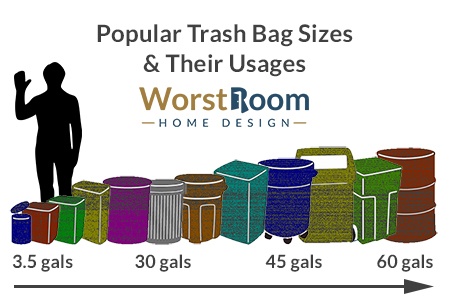
Trash bags come in various sizes to cater to your waste disposal needs. There are small, medium, and large bags available, each with its advantages. Small bags are ideal for daily household use, while larger bags are best for large-scale cleanup projects or demolition. The trash bag sizes chart above shows you how much variation there can be between them all.
If you need something in between, there are medium-sized options as well. When choosing a trash bag, consider its capacity, thickness, and cost to find the best fit for your needs.
Did you know that even different countries have different standard bin sizes?
For example, in the United States, there are square, rectangular, and round trash cans with a range of bag sizes from 3.5 gallons to 60 gallons. The US's measurement for both bins and bags is in inches and gallons. Various strengths and types of bags are available, including drawstring and tab options, standard bags with no tabs or string, and stand-up bags.
Current popular sizes include (with suggested usages):
- 3.5 - 4 gallon | bathroom
- 7 - 10 gallon | kitchen
- 13 - 15 gallon | business space
- 16 - 20 gallon | shared space
- 21 - 25 gallon | common room
- 26 - 30 gallon | shared trafficked area
- 31 - 35 gallon | outdoor disposal
- 40 - 45 gallon | heavily trafficked area
- 46 - 50 gallon | commercial areas
- 56 - 60 gallon | industrial waste
While these are popular sizes, there are really a smaller set of even more standard trash bag sizes that fit the most commonly manufactured and purchased garbage can sizes, which we discuss below.
Common Trash Bag Shapes
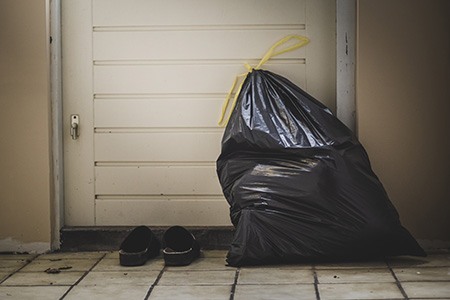
Regarding trash bags, there are two main shapes: square and rectangular. You can find circular bags in the smallest and largest sizes, though it's rare in between. Your particular needs will determine the best choice for you. Square bags are convenient in design, while rectangular bags are the most widely available and cost-effective choice.
Additionally, rectangular bags are suitable for stacking if you have a recycling system. In terms of space, two rectangular bags may take up the same amount of room as one square bag, based on their dimensions.
Square vs. Rectangular Trash Bags
The choice between square and rectangular trash bags is a matter of personal preference and practicality. Square bags offer advantages such as fitting easily into tight spaces and holding odd-shaped items due to their wider brim. However, they can be more expensive and not as good at holding larger amounts of waste.
However, rectangular bags are popular due to their cost-effectiveness and versatility. They can be easily stacked side by side for recycling, making them the preferred option for many households.
The bags are also readily available in different sizes, making them versatile for various waste types and sizes. Whether you're cleaning up your kitchen, bathroom, or office, a rectangular trash bag will do the job just fine.
Ultimately, the best trash bag for you depends on your individual needs and the waste you dispose of. Square bags are an excellent option for smaller and oddly shaped waste, while rectangular bags are the most cost-effective and versatile choice.
Consider the location, the amount of waste, and the trash bin size before making your decision, and you'll be sure to find the right type of trash bag for you. You can have a small trash can in your laundry room and as long as you don't put organic material in there, your laundry room will never stink (at least for that reason).
It should be noted that while many people think of square trash bags as circular, they typically aren't (though some do exist in smaller sizes). It's usually the case that the bag is square even if the can is round, much like putting a rectangular, plastic grocery bag into a small, round bathroom trash can. The volume of these plastic trash bag sizes are typically 2.5 to 5 gallons, perfect for bathrooms.
What Size Trash Bag Fits My Trash Bin & How Do I Know?
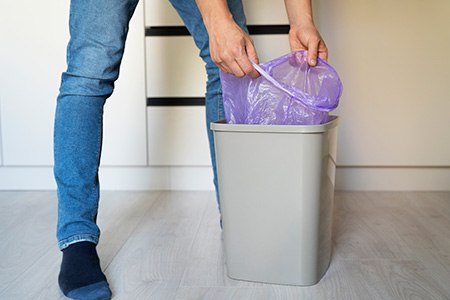
Now that you have a trash bin and know how to use it, how do you pick the appropriate trash bag? The wrong bag can be too tight, tear easily, or not fully contain the waste due to a poor fit around the can. On the other hand, a bag that is too big might slip inside the bin or get caught on items, causing some of the waste to spill out.
There are two key factors (and a better method below) to consider based on the size of the can to determine the correct size of the trash bag. You don't have to do these calculations. I just want you to know how the volumes are derived. We have a better trick just below.
1) For round trash cans, calculate the width of the bag by taking the diameter, multiplying by 3.14, and dividing by two. Then, measure the height of the can and add a few extra inches (2 to 4 inches) to account for the overhang and the base of the bin.
2) For square or rectangular trash cans, determine the width of the bag by measuring the perimeter (adding up all the sides of the can) and dividing by two. Then, measure the height of the can and add 2 to 4 inches.
Utilizing these simple calculations, you can ensure that your trash bag fits appropriately and covers the bottom of the can. Measurements are crucial to prevent the bag from slipping, dropping waste, or tearing as you lift it out. A properly fitting trash bag means clean and efficient waste disposal.
Trash Bag Reality Check - How to Know Which Size Trash Bag to Use
Now that you read that nonsense (yes, that's what I think it is), all you really need to do is look at the trash can and find either an imprint on the bottom or side or a sticker and it will tell you the volume of the trash can and the suggested trash bag size to use. That's the volume of trash bag that you should get. The volume is often a part of the model name, too.
Manufacturers don't make wildly different sizes. The trash cans and the trash bags are all designed to match each other, such as in the list just below here. You will find a bag to match the trash can perfectly, and the can will tell you its own volume and which size trash bag is most appropriate.
What Trash Bag Size Should I Use for Each Room?
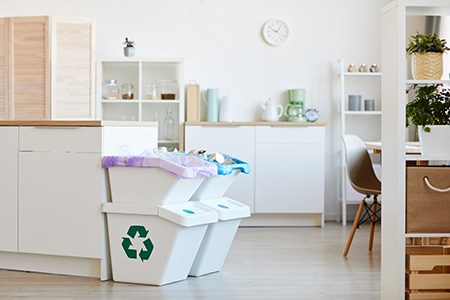
Choosing the correct trash can and garbage bag sizes for each room is essential, as different rooms generate different amounts of waste. Here is a guide to help you select the appropriate trash can size for each room:
- Bathroom or bedroom: 2.5 - 4 gallon can
- Kitchen: 8 - 13 gallon can
- Office, business, or study: 13 - 16 gallon can
- Shared space: 16 - 20 gallon can
- Large office, storage, or common room: 21 - 25 gallon can
- Large waste disposal: 31 - 35 gallon can
- Outdoor waste disposal: 40 - 45 gallon can
- Commercial use or big cleanups: 56 - 60 gallon can
What you'll find as you shop is there are standard size trash bags for each room and often trash cans and trash bags are labeled as such. For instance, you'll find 13 gallon trash bags being labeled as "kitchen trash bags". Though kitchen size garbage bags vary a bit, there's zero harm in having a size a bit too big. This makes things simpler for us because who can remember all these numbers?
Large trash bag sizes and cans are better for businesses as more people contribute to the waste. Commercial kitchens or construction sites require larger and more durable trash cans to hold heavy and liquid waste.
Considerations for Choosing a Trash Can Size for Your Home

Here’s a series of questions to ask yourself to help you deal with the process of elimination and choose the most appropriate size of trash can.
- What room is it for?
- How many people live in your home?
- How much trash do you create?
- How much space do you have?
- What size bag do you prefer?
Two factors determine the ideal size of a kitchen trash can: the amount of waste produced and the can's location. If you generate a large amount of waste through cooking, you'll need a sturdy and leak-proof can with a lid to keep odors at bay. The typical kitchen trash bag size is 13 gallons. This is one of the standard trash bag sizes where it's hard to even stray away from it.
When choosing a location for the can, ensure that it fits properly. For example, if you place it under the sink, ensure it's not too tall, and if you put it outside the sink area, ensure it has a lid to prevent any unpleasant odors and to keep any tiny ants from marching around your kitchen.
Do Countries Have Different Size Trash Bags?
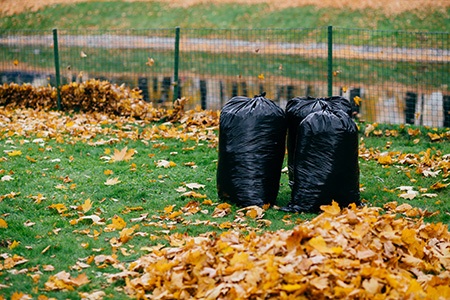
Did you know that the names and sizes of trash cans and bags can vary by country? For instance, in the UK and Australia, trash cans are commonly referred to as rubbish bins or garbage bins, and their bags have various names, such as garbage bags, bin liners, rubbish bags, or refuse sacks. They measure trash bags in centimeters and liters.
The standard wheelie bin for outdoor household waste is larger than the US standard, with a capacity of 240 liters or 64 gallons. Additionally, there are separate bins for recycling and green waste and smaller two-wheel bins provided by councils.
The Crash Course on Trash Bag Sizes is Complete!
It's important to keep cost in mind when choosing trash bags. Although all trash bags serve the same purpose, there can be a wide range in price depending on their size and thickness.
Typically, 13 gallon trash bags are the most budget-friendly option, while 20 gallon bags are mid-priced. For larger, more heavy-duty tasks such as commercial use, 33 gallon and 45 gallon bags may be pricier but are also more durable. Regardless of the job size, there is a trash bag to match it effectively.
In conclusion, choosing the right trash bag size is essential for effective waste management. Consider the size of your trash can, the volume, the type of trash, and environmental considerations when selecting a trash bag size.
Whether you need a standard or specialty trash bag, trash bag sizes are available to meet your needs. Always use the correct size trash bag to help keep your home or business clean and tidy and reduce the environmental impact.




